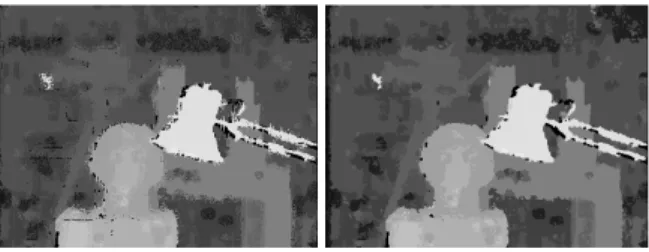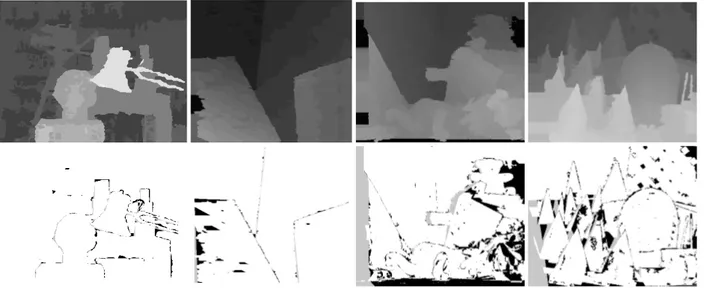Confidence-based cost modulation for stereo matching
Riccardo Gherardi
Dipartimento di Informatica, University of Verona
Strada Le Grazie, 15 - 37134 Verona, IT
[email protected]
Abstract
We present a novel operator to be applied at raw matching costs in the context of low level vision tasks such as stereo matching or optical flow. It aims at im-proving matching reliability by efficiently modulating pixel-wise pairing costs, injecting a confidence backed bias before the aggregation step. It works analyzing a noisy estimate of the correspondances in order to fa-vor or prune potential matches. We test the operator by developing a local, realtime stereo matching algorithm and showing that our solution can drastically clean the resulting depth map while also reducing border bleed-ing. Its good performance is also evaluated quanti-tavely by testing the algorithm against the popular Mid-dlebury benchmark where our local greedy implemen-tation is able to obtain results comparable to those of n¨aive global approaches.
1. Introduction
We describe a novel pixel-wise operator aimed at refining and improving the reliability of a underlying matching cost in the context of low level vision. The current trend for tasks like stereo matching and optical flow computation has been an ever-increasing sofistica-tion, exacerbated and fueled by the publication of com-mon dataset and benchmarks [9, 1]. The top performers in each category are often composed of several complex modules like plane fitting, edge-preserving smoothing, image segmentation and many others.
It’s easy to see that any improvement in the earliest step of the matching computation, namely in the cal-culation of the first matching cost, can have profound and beneficial effects on the remainder of a algorithm pipeline.
In this paper we propose a simple and efficient oper-ator capable of drastically pruning potential correspon-dances for a pixel. It works analyzing (or in a sense,
re-fining) a noisy initial approximation of the depth or flow map, smoothly inhibiting matching pairs without suffi-cient support in a local, unstructured neighbourhood.
To support our claim that incorporating such oper-ator into existing algorithms could provide additional reliability while allowing a simplification in the regular-ization tecniques, we implement a local, greedy stereo matching implementation whose results are comparable to n¨aive global approaches at a fraction of the sofistica-tion and time complexity.
The rest of the paper is organized as follows: in sec-tion 2 we briefly cover the related literature; secsec-tion 3 will describe our neighbourhood confidence operator, and the following section the algorithm developed to test it. Section 5 will detail the completed experiments. Last section will present our conclusions.
2. Related work
Since the main topic of this article deals with match-ing measures and aggregation strategies we refer the in-terested reader to the following papers [6, 10] for some recent and fair comparaison.
Regarding the representation of confidence, litera-ture reports several successfull approaches in stereo matching research. Historically, autocorrelation or the left-right consistency constraint have been used to char-acterize the ambiguity of a pixel, but several other meth-ods exist like for example image entropy or curvature metric [3, 4].
The notion of distinctiveness maps [7], recently rein-terpreted by [11], or that of stability [8] are also recon-ducible to confidence measures.
Confidence is usually employed to guide the match-ing process or the constraint enforcement in a high con-fidence first fashion, or as a weighting function in depth map fusion [5].
Our approach, instead of computing confidence as a by-product of the matching process, extrapolate it a posteriorifrom a initial, given, possibly noisy disparity
978-1-4244-2175-6/08/$25.00 ©2008 IEEE
estimate and use it to directly modulate the underlying matching costs.
3. Confidence-based cost modulation
In the past, confidence measures have usually been calculated as a function of the entire x, y, d space. We propose instead to infer a confidence measure from a initial, possibly noisy estimate of the sought flow or disparity map and to use it to modulate the underlying matching cost function, as follows:
Cx,d0 = P y∈Ne− |dx−dy | k ||N || · [Cx,d− P] + P
Cx,dand Cx,d0 are respectively the old and new native
matching costs for pixel x at disparity d, N is the neigh-bourhood of x and dwrepresents the disparity value of
location w in the given initial estimate of the disparity map.
The value assumed by the first fraction is propor-tional to the ratio of pixels with a similar disparity value found in the chosen neighbourhood (the notion of “sim-ilarity” is controlled by the parameter k). This ratio is then used to modulate a linear interpolation between the actual cost Cx,dand the penalization constant P.
We purposely not inserted any locality principle or distance based penalty because we wanted our operator to be able to non-uniformly incentivate similar regions even if distant or unconnected. The global effect of the operator, when properly configured, is to enable the self-organization of the support regions, favoring com-pactness and inhibiting small or isolated areas. Thin structures, once established, usually provide themselves enough support to thrive.
4. Stereo algorithm
In order to evaluate our confidence modulation we developed as a testbed a simple, local stereo algo-rithm based on a greedy, fixed window correlation al-gorithm. Such methods are simple to implement and well-understood, letting us concentrate on assessing and factoring out the properties and the effects of our pro-posal.
We stress that, even if the resulting algorithm is ca-pable of realtime performance and overall produces de-cent results it was never meant to be compared with the current state of the art but just as a evaluation platform.
4.1. Initial disparity estimation
We start by calculating a initial approximate dispar-ity needed for our confidence operator. We choose as cost matching a truncated version of the popular Birch-field and Tomasi sampling insensitive measure [2]. To aggregate matching cost, we use a 5x5 gaussian filter with σ=2. The resulting disparity map, shown in fig.1, displays all the typical shortcomings of fixed-window correlation algorithms.
Figure 1.Initial disparity estimation.
4.2. Aggregation with modulated costs
Subsequently, we compute a novel disparity map us-ing the modulated values computed from the estimate built in the previous step. Our neighbourhood choice is a uniform disk of radius 7.
Figure 2. Raw and aggregated output of the confi-dence estimator.
The left side of figure 2 shows the map obtained when not using any form of cost aggregation: each pixel then assumes the disparity value that minimizes its cost. The picture presents some curious visual artifacts near discontinuities, caused by the influence of pixels across the depth gap. On the right the same cost volume is
shown but aggregated with a small 3x3, σ=1 gaussian filter.
What both pictures have in common is a drastic de-crease of the noise levels with respect to the initial dis-parity estimation. Other effects include the reduction of border bleeding and the minor entropy of untextured region which are now filled with still wrong yet more uniform disparities.
4.3. Disparity cleaning
In this step we apply some common and simple heuristics to remove small and untextured regions. To remove this second category we compute an estimate of the noise magnitude and variance and use them to threshold the sum of pixel-wise matching costs (fig.3). The resulting regions are then assigned to the best over-all disparity for the entire group. Smover-all holes caused by removing small regions are filled with the minima be-tween the neighbouring left and right disparity. On the right of figure 3 is shown the resulting depth map.
Figure 3.Untextured regions and the cleaned depth map.
4.4. Final regularization step
Since in the previous step we have obtained a new disparity estimate, we can now use it again to produce a confidence modulated depth map. The resulting depth map is further checked for consistency using the unic-ity constraint. The final result is shown in fig.4. It is surprisingly good considering it was produced from a standard winner-take-all window correlation algorithm.
5. Experiments
In order to obtain quantitative results we have run the algorithm described in the previous section on all the four couples in the Middlebury stereo benchmark with and without the proposed confidence based cost modulation. The obtained results are reported in table 1.
Figure 4. Final disparity map for the Tsukuba dataset.
Our complete results on the Middlebury dataset are shown in figure 5: skipping the analysis of the Tsukuba set that was already covered in section 4 we proceed to notice in the Venus couple some of the shortcomings of our n¨aive approach: most of the bad pixels (marked in black) come from disparity holes erroneously filled across disparity boundaries and over untextured region. The Teddy and Cones couples share the same prob-lems, but moreover they show difficulties in filling im-age borders. Regarding Teddy, the whole ground plane is missing, because its steep angle and fine texture are completely incompatible with fixed-window correlation algorithms.
Overall, we can state that the obtained results are surprisingly good considering that they were computed with a local algorithm just by modulating its cost func-tion. The method, while stabilizing itself in the lower half of the Middlebury table is at par with low-end global implementations.
Table 1.Comparaison of stereo results.
Image pair with Cost modulation without
Tsukuba 1.7723 8.741 Venus 2.3332 22.141 Teddy 15.034 24.341 Cones 10.033 21.441 Overall 30.9 76.5
6. Conclusions
We presented a novel confidence-based operator aimed at improving the reliability of an underlying
Figure 5.Results on the Middlebury dataset: Tsukuba, Venus, Teddy and Cones.
matching cost. The performance improvement has been demonstrated on a local, greedy stereo algorithm based on window correlation: our proposal was shown to dra-matically improve the signal to noise ratio as well as to help better localize the borders. The performed quan-titave evaluation demostrated that using our improved, confidence backed matching costs a local approach can obtain results surprising for a correlation-based algo-rithm and comparable to those of low-end global ap-proaches, at a fraction of the sofistication and time com-plexity.
References
[1] S. Baker, S. Roth, D. Scharstein, M. Black, J. Lewis, and R. Szeliski. A database and evaluation methodol-ogy for optical flow. In Computer Vision, 2007. ICCV 2007. IEEE 11th International Conference on, pages 1– 8, 2007.
[2] S. Birchfield and C. Tomasi. A pixel dissimilarity mea-sure that is insensitive to image sampling. IEEE Trans-actions on Pattern Analysis and Machine Intelligence, 20(4):401–406, Apr. 1998.
[3] G. Egnal, M. Mintz, and R. P. Wildes. A stereo confi-dence metric using single view imagery with compari-son to five alternative approaches. Image Vision Com-put., 22(12):943–957, 2004.
[4] A. Fusiello, V. Roberto, and E. Trucco. Symmetric stereo with multiple windowing. IJPRAI, 14(8):1053– 1066, 2000.
[5] M. Goesele, B. Curless, and S. M. Seitz. Multi-view stereo revisited. In CVPR (2), pages 2402–2409, 2006. [6] H. Hirschm¨uller and D. Scharstein. Evaluation of cost
functions for stereo matching. In CVPR, 2007. [7] R. Manduchi and C. Tomasi. Distinctiveness maps for
image matching. Image Analysis and Processing, 1999. Proceedings. International Conference on, pages 26– 31, 1999.
[8] R. Sara. Finding the largest unambiguous component of stereo matching. Proceedings 7th European Con-ference on Computer Vision (ECCV2002), 2:900–914, may 2002.
[9] D. Scharstein and R. Szeliski. A taxomomy and eval-uation of dense two-frame stereo correspondence algo-rithms. International Journal of Computer Vision, IJCV, 47(1):7–42, april 2002.
[10] L. Wang, M. Gong, M. Gong, and R. Yang. How far can we go with local optimization in real-time stereo match-ing. 3D Data Processing, Visualization, and Transmis-sion, Third International Symposium on, pages 129– 136, June 2006.
[11] K.-J. Yoon and I. S. Kweon. Stereo matching with the distinctive similarity measure. Computer Vision, 2007. ICCV 2007. IEEE 11th International Conference on, pages 1–7, 14-21 Oct. 2007.


